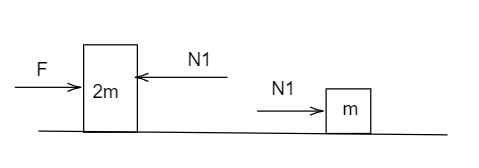
Two blocks are in contact on a frictionless table. One has mass m and the other 2m a force F is applied on 2m as shown in the figure. Now the same force F is applied from the right on m. In the two cases respectively, the ratio of the force of contact between the two blocks will be:

(A) same
(B) $1:2$
(C) $2:1$
(D) $1:3$
Answer
217.8k+ views
Hint Due to the force of contact both the masses will move together with the same acceleration. Force of contact acting between the two blocks will be the driving force for the movement for block m (when force is acting from the left side) and 2m (when force is acting from the right side).
Formula used: $F = ma$ where F is force, m is mass and a is acceleration
Complete Step-by-step solution
Let, case A be the case in which force is acting on the left side i.e. on block 2m and case B be the case in which force is acting on the right side i.e. on block m.
Due to the force of contact both the masses will move together with the same acceleration.
Hence,
$F = ma$ where F is force, m is mass and a is acceleration
Here, considering both the blocks as one system,
$F = 3ma$
$a = \dfrac{F}{{3m}}$
In case A force of contact will cause movement of the block of mass m.
In case B force of contact will cause movement of a block of mass 2m.
Let ${N_1}$ be the force of contact in case A and ${N_2}$ be the force of contact in case B.
We know that$F = ma$
So,

$ \Rightarrow {N_1} = m \times \dfrac{F}{{3m}}$
$ \Rightarrow {N_1} = \dfrac{F}{3}$
So,

$ \Rightarrow {N_2} = 2m \times \dfrac{F}{{3m}}$
$ \Rightarrow {N_2} = \dfrac{{2F}}{3}$
In the question they are asking ratio of ${N_1}$ to ${N_2}$ i.e. ${N_1}:{N_2}$ that is,
\[ \Rightarrow \dfrac{F}{3}:\dfrac{{2F}}{3}\]
$ \therefore 1:2$
$\therefore $ The correct answer is $(B) 1:2$
Note Above we solved considering the free body diagram of the body on which force of contact is acting but we can also solve it by considering the free body diagram of other body by balancing force on it and following $F = ma$where F is force, m is mass and a is acceleration
Formula used: $F = ma$ where F is force, m is mass and a is acceleration
Complete Step-by-step solution
Let, case A be the case in which force is acting on the left side i.e. on block 2m and case B be the case in which force is acting on the right side i.e. on block m.
Due to the force of contact both the masses will move together with the same acceleration.
Hence,
$F = ma$ where F is force, m is mass and a is acceleration
Here, considering both the blocks as one system,
$F = 3ma$
$a = \dfrac{F}{{3m}}$
In case A force of contact will cause movement of the block of mass m.
In case B force of contact will cause movement of a block of mass 2m.
Let ${N_1}$ be the force of contact in case A and ${N_2}$ be the force of contact in case B.
We know that$F = ma$
So,

$ \Rightarrow {N_1} = m \times \dfrac{F}{{3m}}$
$ \Rightarrow {N_1} = \dfrac{F}{3}$
So,

$ \Rightarrow {N_2} = 2m \times \dfrac{F}{{3m}}$
$ \Rightarrow {N_2} = \dfrac{{2F}}{3}$
In the question they are asking ratio of ${N_1}$ to ${N_2}$ i.e. ${N_1}:{N_2}$ that is,
\[ \Rightarrow \dfrac{F}{3}:\dfrac{{2F}}{3}\]
$ \therefore 1:2$
$\therefore $ The correct answer is $(B) 1:2$
Note Above we solved considering the free body diagram of the body on which force of contact is acting but we can also solve it by considering the free body diagram of other body by balancing force on it and following $F = ma$where F is force, m is mass and a is acceleration
Recently Updated Pages
Arithmetic, Geometric & Harmonic Progressions Explained

Cartesian Form of Vector Explained: Formula, Examples & Uses

Apparent Frequency Explained: Formula, Uses & Examples

Calorimetry: Definition, Principles & Calculations

Centrifugal Force Explained: Definition, Formula & Examples

Charge in a Magnetic Field: Definition, Formula & Examples

Trending doubts
JEE Main 2026: Application Form Open, Exam Dates, Syllabus, Eligibility & Question Papers

Derivation of Equation of Trajectory Explained for Students

Hybridisation in Chemistry – Concept, Types & Applications

Understanding the Angle of Deviation in a Prism

Understanding Collisions: Types and Examples for Students

How to Convert a Galvanometer into an Ammeter or Voltmeter

Other Pages
JEE Advanced Marks vs Ranks 2025: Understanding Category-wise Qualifying Marks and Previous Year Cut-offs

Units And Measurements Class 11 Physics Chapter 1 CBSE Notes - 2025-26

NCERT Solutions For Class 11 Physics Chapter 8 Mechanical Properties Of Solids

Motion in a Straight Line Class 11 Physics Chapter 2 CBSE Notes - 2025-26

NCERT Solutions for Class 11 Physics Chapter 7 Gravitation 2025-26

Understanding Atomic Structure for Beginners




